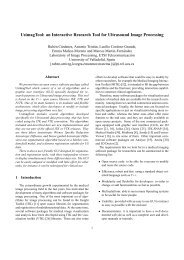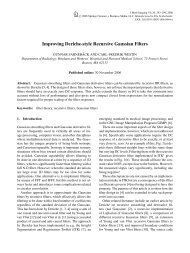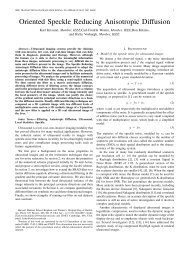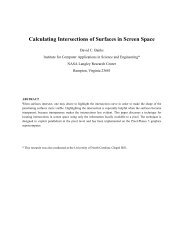Download full paper [PDF] - Laboratory of Mathematics in Imaging
Download full paper [PDF] - Laboratory of Mathematics in Imaging
Download full paper [PDF] - Laboratory of Mathematics in Imaging
Create successful ePaper yourself
Turn your PDF publications into a flip-book with our unique Google optimized e-Paper software.
Matsuoka, Washko, Yamashiro, et al.: Pulmonary Hypertension <strong>in</strong> Severe Emphysema 221Figure 2. The relationship between the pulmonary arterial meanpressure (Ppa) and (A) the percentage <strong>of</strong> the area taken up by thecross-sectional area (CSA) <strong>of</strong> pulmonary vessels smaller than 5 mm 2(%CSA ,5 ), and (B) the percentage <strong>of</strong> the area taken up by the CSA <strong>of</strong>pulmonary vessels between 5 mm 2 and 10 mm 2 (%CSA 5–10 ). Ppa hasa significant negative correlation with %CSA ,5 (r 5 20.512, P ,0.0001), whereas there is no significant correlation between Ppa and%CSA 5–10 (r 520.196, P 5 0.083).ship between pulmonary arterial pressure and small vesselmorphology <strong>in</strong> severe emphysema. Vascular remodel<strong>in</strong>g <strong>of</strong>small pulmonary vessels, which ma<strong>in</strong>ly consists <strong>of</strong> <strong>in</strong>timalthicken<strong>in</strong>g <strong>of</strong> the pulmonary muscular artery, is believed to bethe most important factor <strong>in</strong> the development <strong>of</strong> pulmonaryhypertension <strong>in</strong> severe emphysema, although the relationshipbetween vascular alteration and pulmonary hypertension is notyet proved. However, pulmonary vascular remodel<strong>in</strong>g is notexclusively a characteristic <strong>of</strong> severe emphysema; it has alsobeen shown <strong>in</strong> patients with mild COPD and <strong>in</strong> smokers withnormal pulmonary function (22–28). Previous authors have notfound a significant correlation between vascular remodel<strong>in</strong>g andPpa at rest (29, 30). In contrast, Kubo and colleagues (7) foundthat pulmonary vascular remodel<strong>in</strong>g assessed histologically <strong>in</strong>severe emphysema led to reduced distensibility <strong>of</strong> pulmonaryvessels and was closely correlated to Ppa dur<strong>in</strong>g exercise, butnot at rest. Wright and colleagues (31) demonstrated that Ppacorrelates with vascular mediators that control vasoconstrictionor vasodilation <strong>of</strong> pulmonary vessels. Thus, the degree <strong>of</strong>pulmonary arterial pressure <strong>in</strong> COPD may be related to thedynamic morphological change <strong>in</strong> the pulmonary vascular bedFigure 3. The relationship between the pulmonary arterial mean pressure(Ppa) and (A) the diameter <strong>of</strong> ma<strong>in</strong> pulmonary artery (MPAD), and(B) the ratio <strong>of</strong> MPAD to the diameter <strong>of</strong> ascend<strong>in</strong>g aorta (MPAD/AoD).There is no significant correlation between Ppa and MPAD or MPAD/AoD.rather than static or histological vascular alteration. The%CSA ,5 may reflect the effects <strong>of</strong> the vascular distensibilityand vasoactive mediators because it is measured <strong>in</strong> vivo; thismay expla<strong>in</strong> the significant correlation between %CSA ,5 andPpa <strong>in</strong> our study, although decrease <strong>in</strong> total capillary bed maybe associated with Ppa because Ppa had a significant correlationwith DL CO % predicted.We confirmed that the relationship between vascular alterationand Ppa depends on vessel size. A significant correlationTABLE 4. PREDICTORS OF PULMONARY MEAN ARTERIALPRESSURE FROM MULTIPLE REGRESSION ANALYSIS (N 5 79)Partial Regression CoefficientP Value%CSA ,5 (%) 223.88 ,0.0001%LAA 2950 20.09 0.054FEV 1 , % predicted 20.04 0.549DL CO , % predicted 20.13 0.022Pa O2 20.08 0.067Age 20.01 0.936Sex 20.37 0.453BMI 0.01 0.268Def<strong>in</strong>ition <strong>of</strong> abbreviations: BMI 5 body mass <strong>in</strong>dex; DL CO 5 diffus<strong>in</strong>gcapacity <strong>of</strong> the lung for carbon monoxide; Ppa 5 pulmonary arterial meanpressure; %LAA 2950 5 CT measurement <strong>of</strong> the percentage <strong>of</strong> low attenuationarea less than 2950 HU, def<strong>in</strong>ed as emphysema.


![Download full paper [PDF] - Laboratory of Mathematics in Imaging](https://img.yumpu.com/49647991/4/500x640/download-full-paper-pdf-laboratory-of-mathematics-in-imaging.jpg)
![Download full paper [PDF] - Laboratory of Mathematics in Imaging](https://img.yumpu.com/42711677/1/190x253/download-full-paper-pdf-laboratory-of-mathematics-in-imaging.jpg?quality=85)






![Download full paper [PDF] - Laboratory of Mathematics in Imaging](https://img.yumpu.com/23088308/1/190x255/download-full-paper-pdf-laboratory-of-mathematics-in-imaging.jpg?quality=85)
